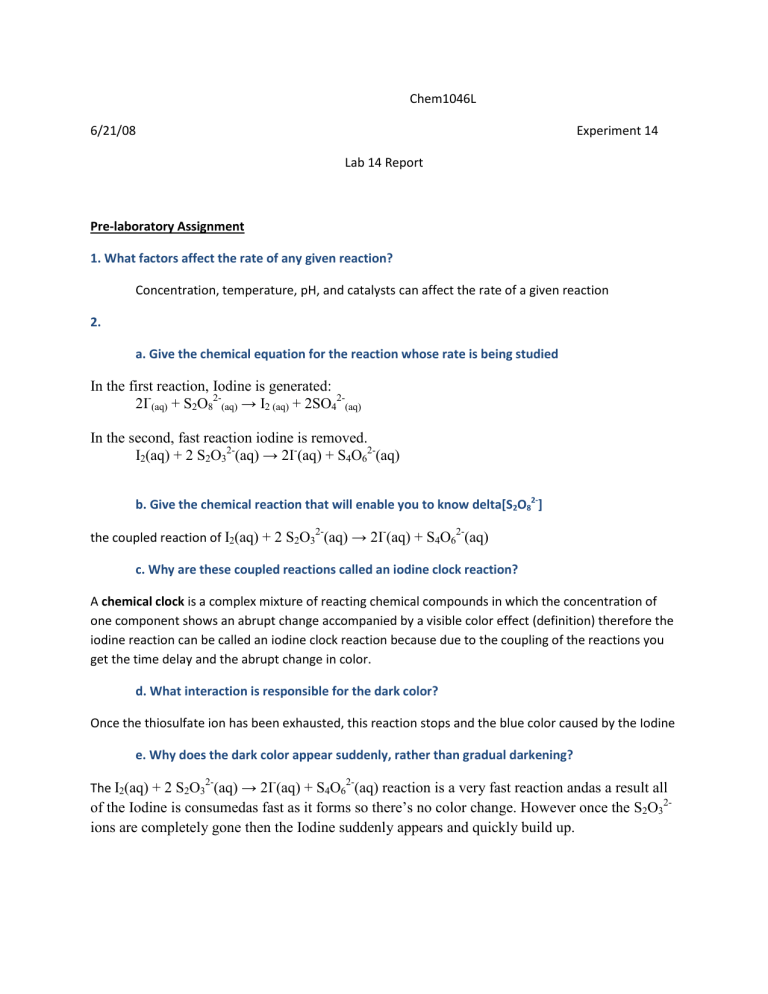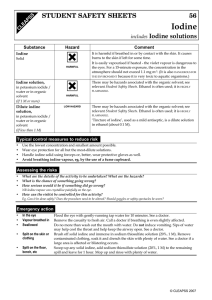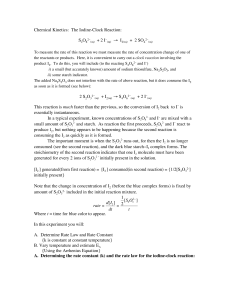
Chem1046L 6/21/08 Experiment 14 Lab 14 Report Pre-laboratory Assignment 1. What factors affect the rate of any given reaction? Concentration, temperature, pH, and catalysts can affect the rate of a given reaction 2. a. Give the chemical equation for the reaction whose rate is being studied In the first reaction, Iodine is generated: 2I-(aq) + S2O82-(aq) → I2 (aq) + 2SO42-(aq) In the second, fast reaction iodine is removed. I2(aq) + 2 S2O32-(aq) → 2I-(aq) + S4O62-(aq) b. Give the chemical reaction that will enable you to know delta[S2O82-] 2- - 2- the coupled reaction of I2(aq) + 2 S2O3 (aq) → 2I (aq) + S4O6 (aq) c. Why are these coupled reactions called an iodine clock reaction? A chemical clock is a complex mixture of reacting chemical compounds in which the concentration of one component shows an abrupt change accompanied by a visible color effect (definition) therefore the iodine reaction can be called an iodine clock reaction because due to the coupling of the reactions you get the time delay and the abrupt change in color. d. What interaction is responsible for the dark color? Once the thiosulfate ion has been exhausted, this reaction stops and the blue color caused by the Iodine e. Why does the dark color appear suddenly, rather than gradual darkening? The I2(aq) + 2 S2O32-(aq) → 2I-(aq) + S4O62-(aq) reaction is a very fast reaction andas a result all of the Iodine is consumedas fast as it forms so there’s no color change. However once the S2O32ions are completely gone then the Iodine suddenly appears and quickly build up. f. When the dark color appears delta[S2O82-] = delta[S2O32-], where delta[S2O32-] equal the initial concentration of NA2S2O3. Why? Because the S2O32- and the S2O82- have reached an equilibrium and the reaction happen at the same rate both ways in the reactions 3. Consider the composition of the solutions in Table 14.1. In which experiment will the longest time elapse before the appearances of the dark color. Why? Number one because it has the greatest number of over all components to keep the second reaction running and sucking up the Iodine. 4. What catalyst will be used? In which experiment will it be used? CuSO4 - Copper Sulfate 5. Give the name os these substances: a. K2S2O8 Potassium per sulfate b. S2O82persulfate ion c. Na2S2O3 Sodium thiosulfate d. S2O32thiosulfate ion DATA Room temp:22.2 degrees Celsius Experiment 1 2 3 4 5 Time 2min 07sec 59sec 1min 22sec 1min 06sec 06.22sec Temp (Celsius) 35 (11mL)





